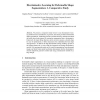Free Online Productivity Tools
i2Speak
i2Symbol
i2OCR
iTex2Img
iWeb2Print
iWeb2Shot
i2Type
iPdf2Split
iPdf2Merge
i2Bopomofo
i2Arabic
i2Style
i2Image
i2PDF
iLatex2Rtf
Sci2ools
ECCV
2008
Springer
2008
Springer
Discriminative Learning for Deformable Shape Segmentation: A Comparative Study
Abstract. We present a comparative study on how to use discriminative learning methods such as classification, regression, and ranking to address deformable shape segmentation. Traditional generative models and energy minimization methods suffer from local minima. By casting the segmentation into a discriminative framework, the target fitting function can be steered to possess a desired shape for ease of optimization yet better characterize the relationship between shape and appearance. To address the high-dimensional learning challenge present in the learning framework, we use a multi-level approach to learning discriminative models. Our experimental results on left ventricle segmentation from ultrasound images and facial feature point localization demonstrate that the discriminative models outperform generative models and energy minimization methods by a large margin.
Computer Vision | Deformable Shape Segmentation | Discriminative Framework | Discriminative Learning Methods | Discriminative Models | ECCV 2008 | Energy Minimization Methods |
| Added | 15 Oct 2009 |
| Updated | 15 Oct 2009 |
| Type | Conference |
| Year | 2008 |
| Where | ECCV |
| Authors | Jingdan Zhang, Shaohua Kevin Zhou, Dorin Comaniciu, Leonard McMillan |
Comments (0)

